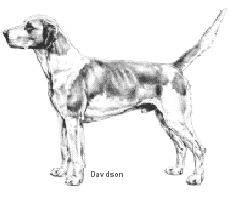Foxhound
General Information - Foxhound

Group:
Hound
Size:
large
Lifespan:
10-13 years
Exercise:
high
Grooming:
low
Trainability:
very low
Watchdog ability:
high
Protection ability:
medium
Area of Origin:
England
Date of Origin:
1700s
Other Names:
English Foxhound
Original Function:
Trailing fox in
packs
History
The Foxhound traces its ancestry back to the St Hubert Hound, and goes back to the 1600's. It was developed specifically to hunt foxes, and so requires great stamina, strength, speed, and scenting powers, not to mention a good "voice". These dogs are pack animals and thrive best with the company of other dogs.
Temperament
The Foxhound is a very active, bold and passionate hunter. Responsive and obedient to his master... but training takes patience. They are friendly with people and excellent with children, but prefer to be in the company of other dogs and do quite well with other animals. The Foxhound likes to play. They are untiring, able to run for hours at a consistent speed, trotting along through brambles, marshes, and sunny countryside for five or six hours without stopping. The Foxhound us typically found only in hunt packs in the UK, USA and Australia but more are finding there way into homes at show dogs and companions. A Foxhound can in the right environment make a good pet however the owner must be prepared to spend time with their hound, it is not a dog to be left on it’s own.
Upkeep
The Foxhound is an easygoing dog that nonetheless needs plenty of exercise. It is bred to run for miles, and it can make a good jogging companion on leash or a hiking companion in a safe area. It can live outdoors in temperate climates as long as it has warm shelter and bedding and, preferably, another Foxhound. The coat needs only occasional brushing to remove dead hair.
Foxhound
A breed standard is the guideline which describes the ideal characteristics, temperament, and appearance of a breed and ensures that the breed is fit for function with soundness essential. Breeders and judges should at all times be careful to avoid obvious conditions and exaggerations, as well as being mindful of features which could be detrimental in any way to the health, welfare or soundness of this breed.
Breed Standard - Foxhound
 Head and Skull
Head and Skull: Skull broad.
Neck: Long, but not thick. A short:necked hound is deficient in pace.
Forequarters: Shoulders should show quality and no lumber. A shoulder with an excessive amount of fleshy conformation will prevent the hound from running up or down hill at top pace. Legs full of bone right down to the feet, and not tapering off in any way.
Body: Girth should be deep with plenty of heart room. Back broad, and a hound should be well ribbed up; but there should be a fair space between the end of the ribs and the commencement of the hindquarters, otherwise the hound will be deficient in stride and therefore lack pace.
Hindquarters: Full, and of great muscular proportions. Hocks should be well let down, and the bone of the hindlegs (as in the forelegs) should continue all the way down to the foot, and not become light under the pastern.
Feet: The toes of the feet should be close together, and not open.
Tail: Should be well put on at the end of good quarters, and these quarters should in no way end abruptly and be of the type that hound:men term “chopped off behind”. A curly stern, although unsightly, will not be detrimental to the hound’s hunting qualities.
Note: Male animals should have two apparently normal testicles fully descended into the scrotum.
DNZ No 464
Copyright Dogs New Zealand
01 Jan 2002
Any departure from the foregoing points should be considered a fault and the seriousness with which the fault should be regarded should be in exact proportion to its degree and its effect upon the health and welfare of the dog and on the dog’s ability to perform its traditional work.




